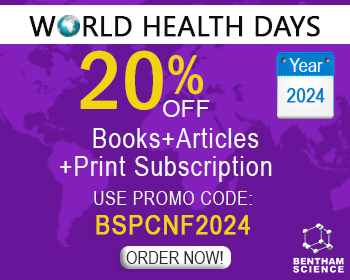Abstract
Parkinson's disease (PD) is the second most common type of neurogenerative disease among middleaged and older people, characterized by aggregation of alpha-synuclein and dopaminergic neuron loss. The microbiota- gut-brain axis is a dynamic bidirectional communication network and is involved in the pathogenesis of PD. The aggregation of misfolded protein alpha-synuclein is a neuropathological characteristic of PD, originates in the gut and migrates to the central nervous system (CNS) through the vagus nerve and olfactory bulb. The change in the architecture of gut microbiota increases the level short-chain fatty acids (SCFAs) and other metabolites, acting on the neuroendocrine system and modulating the concentrations of gamma-Aminobutyric acid (GABA), serotonin, and other neurotransmitters. It also alters the vagus and intestinal signalling, influencing the brain and behaviour by activating microglia and systemic cytokines. Both experimental and clinical reports indicate the role of intestinal dysbiosis and microbiota host interaction in neurodegeneration. Probiotics are live microorganisms that modify the gut microbiota in the small intestine to avoid neurological diseases. Probiotics have been shown in clinical and preclinical studies to be effective in the treatment of PD by balancing the gut microbiota. In this article, we described the role of gut-microbiota in the pathogenesis of PD. The article aims to explore the mechanistic strategy of the gut-brain axis and its relation with motor impairment and the use of probiotics to maintain gut microbial flora and prevent PD-like symptoms.
Keywords: Parkinson’s disease, gut-brain axis, gut-microbiota, probiotics, hypothalamic-pituitary adrenal, short-chain fatty acids.
[http://dx.doi.org/10.1002/mds.20460] [PMID: 15822106]
[http://dx.doi.org/10.1007/s12264-012-1050-z] [PMID: 22233888]
[http://dx.doi.org/10.1155/2016/3121727] [PMID: 27446627]
[http://dx.doi.org/10.1177/0300985815623997] [PMID: 26869150]
[http://dx.doi.org/10.2174/1874205X01610010042] [PMID: 27563362]
[http://dx.doi.org/10.1038/nrneurol.2015.197] [PMID: 26503923]
[http://dx.doi.org/10.1007/s00415-020-09881-6] [PMID: 32436100]
[http://dx.doi.org/10.1093/brain/awab061] [PMID: 33880502]
[http://dx.doi.org/10.1002/glia.23571] [PMID: 30548343]
[http://dx.doi.org/10.1602/neurorx.2.3.484] [PMID: 16389312]
[http://dx.doi.org/10.1016/j.gendis.2019.01.004] [PMID: 31193965]
[http://dx.doi.org/10.1093/aje/kwg068] [PMID: 12777365]
[http://dx.doi.org/10.1136/jnnp-2015-312283] [PMID: 26701996]
[http://dx.doi.org/10.1038/nrgastro.2012.156] [PMID: 22945443]
[http://dx.doi.org/10.1111/j.1574-6976.2008.00123.x] [PMID: 18549407]
[http://dx.doi.org/10.1080/10408398.2018.1484340] [PMID: 29870270]
[http://dx.doi.org/10.2174/1567205015666180904155908] [PMID: 30182854]
[http://dx.doi.org/10.1080/17474124.2021.1869938] [PMID: 33356668]
[http://dx.doi.org/10.1016/j.fshw.2017.07.003]
[http://dx.doi.org/10.1038/nm.4517] [PMID: 29634682]
[http://dx.doi.org/10.1016/S1473-3099(15)00293-5] [PMID: 26311042]
[http://dx.doi.org/10.1038/s41598-017-03066-4] [PMID: 28588199]
[http://dx.doi.org/10.1371/journal.pone.0114664] [PMID: 26132213]
[http://dx.doi.org/10.1096/fj.201901436RR] [PMID: 31480903]
[http://dx.doi.org/10.3748/wjg.v20.i44.16518] [PMID: 25469019]
[http://dx.doi.org/10.1007/s00018-017-2550-9] [PMID: 28643167]
[http://dx.doi.org/10.15698/mic2019.10.693] [PMID: 31646148]
[http://dx.doi.org/10.1038/nrmicro2876] [PMID: 23000955]
[http://dx.doi.org/10.1007/s12035-018-1188-4] [PMID: 29936690]
[http://dx.doi.org/10.1016/j.copbio.2012.08.005] [PMID: 22940212]
[http://dx.doi.org/10.1038/nature11551] [PMID: 22972296]
[http://dx.doi.org/10.1016/j.phrs.2012.10.007] [PMID: 23089410]
[http://dx.doi.org/10.1038/emm.2017.36] [PMID: 28546563]
[http://dx.doi.org/10.1038/s41467-020-18871-1] [PMID: 33060586]
[http://dx.doi.org/10.1038/nrgastro.2009.35] [PMID: 19404271]
[http://dx.doi.org/10.1016/S0022-3999(02)00429-4] [PMID: 12377295]
[http://dx.doi.org/10.1053/j.gastro.2014.02.037] [PMID: 24583088]
[PMID: 1662661]
[http://dx.doi.org/10.1111/nmo.12378] [PMID: 24888394]
[http://dx.doi.org/10.1002/bies.201400075] [PMID: 25145752]
[http://dx.doi.org/10.1136/gutjnl-2012-302167] [PMID: 22730468]
[http://dx.doi.org/10.1111/apt.12728] [PMID: 24665829]
[http://dx.doi.org/10.1111/j.1572-0241.2005.00230.x]
[http://dx.doi.org/10.1073/pnas.1010529108] [PMID: 21282636]
[http://dx.doi.org/10.3181/00379727-126-32430] [PMID: 6066182]
[http://dx.doi.org/10.1007/BF01537265] [PMID: 2752868]
[http://dx.doi.org/10.1152/ajpgi.2001.280.3.G368] [PMID: 11171619]
[http://dx.doi.org/10.1126/science.291.5505.881] [PMID: 11157169]
[http://dx.doi.org/10.1111/j.1365-2982.2010.01620.x] [PMID: 21054680]
[http://dx.doi.org/10.1038/mp.2012.77] [PMID: 22688187]
[http://dx.doi.org/10.4161/gmic.22973] [PMID: 23202796]
[http://dx.doi.org/10.1073/pnas.1102999108] [PMID: 21876150]
[http://dx.doi.org/10.1053/j.gastro.2011.04.052] [PMID: 21683077]
[http://dx.doi.org/10.1371/journal.pone.0106503] [PMID: 25202975]
[http://dx.doi.org/10.1111/j.1365-2982.2011.01796.x] [PMID: 21988661]
[http://dx.doi.org/10.1038/nrmicro1836] [PMID: 18197168]
[http://dx.doi.org/10.1073/pnas.86.19.7378] [PMID: 2552441]
[http://dx.doi.org/10.1073/pnas.0604343103] [PMID: 16803956]
[http://dx.doi.org/10.1111/j.1365-2672.2007.03287.x] [PMID: 17448154]
[PMID: 1627747]
[http://dx.doi.org/10.1016/0016-5085(89)91678-8] [PMID: 2571543]
[http://dx.doi.org/10.1159/000477990] [PMID: 28651250]
[http://dx.doi.org/10.1016/j.celrep.2021.110090] [PMID: 35021075]
[http://dx.doi.org/10.1038/nrneurol.2012.242] [PMID: 23183883]
[http://dx.doi.org/10.1038/srep34477] [PMID: 27708338]
[http://dx.doi.org/10.1007/s00401-014-1343-6] [PMID: 25296989]
[http://dx.doi.org/10.1016/S0140-6736(04)17103-1] [PMID: 15451224]
[http://dx.doi.org/10.1371/journal.pone.0028032] [PMID: 22145021]
[http://dx.doi.org/10.1016/j.expneurol.2009.07.025] [PMID: 19664623]
[http://dx.doi.org/10.1016/j.cell.2016.11.018] [PMID: 27912057]
[http://dx.doi.org/10.3390/cells9081909] [PMID: 32824536]
[http://dx.doi.org/10.3389/fimmu.2020.604054] [PMID: 33365031]
[http://dx.doi.org/10.1038/s41598-018-32366-6] [PMID: 30242285]
[http://dx.doi.org/10.1136/adc.60.10.979] [PMID: 2933006]
[http://dx.doi.org/10.4161/21688370.2014.982426] [PMID: 25838985]
[http://dx.doi.org/10.1111/j.1420-9101.2009.01809.x] [PMID: 19678866]
[http://dx.doi.org/10.1111/imr.12189] [PMID: 24942683]
[http://dx.doi.org/10.3390/cells8020193] [PMID: 30813280]
[http://dx.doi.org/10.3389/fimmu.2018.00693] [PMID: 29675025]
[http://dx.doi.org/10.1155/2016/1469780]
[http://dx.doi.org/10.1111/imr.12192] [PMID: 24942685]
[http://dx.doi.org/10.1038/nri2343] [PMID: 18566595]
[http://dx.doi.org/10.1038/ni1420] [PMID: 17110939]
[http://dx.doi.org/10.1038/mi.2016.14] [PMID: 26931062]
[http://dx.doi.org/10.1073/pnas.1000092107] [PMID: 20826446]
[http://dx.doi.org/10.3748/wjg.v20.i1.6] [PMID: 24415853]
[http://dx.doi.org/10.1146/annurev-immunol-030409-101330] [PMID: 20192812]
[http://dx.doi.org/10.1371/journal.pone.0046399]
[http://dx.doi.org/10.2174/156652408784533760] [PMID: 18537635]
[PMID: 15505750]
[http://dx.doi.org/10.4161/21645515.2014.979640] [PMID: 25625930]
[http://dx.doi.org/10.1016/j.cell.2010.03.040] [PMID: 20434986]
[http://dx.doi.org/10.1038/s41467-018-06048-w] [PMID: 30201970]
[http://dx.doi.org/10.1016/j.cell.2014.03.011] [PMID: 24679531]
[http://dx.doi.org/10.1093/intimm/dxu066] [PMID: 24948595]
[http://dx.doi.org/10.1038/mp.2016.46] [PMID: 27090302]
[http://dx.doi.org/10.1016/j.bbi.2017.03.002] [PMID: 28263786]
[http://dx.doi.org/10.3389/fonc.2018.00322] [PMID: 30186768]
[http://dx.doi.org/10.1097/MIB.0000000000001078] [PMID: 28296819]
[http://dx.doi.org/10.1016/j.immuni.2015.11.015] [PMID: 26682986]
[http://dx.doi.org/10.1016/j.immuni.2016.10.001] [PMID: 27793594]
[http://dx.doi.org/10.1111/j.1365-2567.2010.03301.x] [PMID: 20545783]
[http://dx.doi.org/10.1016/j.immuni.2013.02.024] [PMID: 23791646]
[http://dx.doi.org/10.1126/science.aam5336] [PMID: 28774928]
[http://dx.doi.org/10.1038/s41564-018-0229-0] [PMID: 30202015]
[http://dx.doi.org/10.1038/nm.4106] [PMID: 27158906]
[http://dx.doi.org/10.1038/cr.2011.13] [PMID: 21243012]
[http://dx.doi.org/10.1007/978-1-4939-0897-4_14]
[http://dx.doi.org/10.3389/fmicb.2018.01948]
[http://dx.doi.org/10.1155/2013/526860]
[http://dx.doi.org/10.1016/j.chom.2018.08.009] [PMID: 30212649]
[http://dx.doi.org/10.1038/s41385-018-0042-3] [PMID: 29867078]
[http://dx.doi.org/10.1016/j.bbi.2018.02.005] [PMID: 29471030]
[http://dx.doi.org/10.3389/fnagi.2017.00441] [PMID: 29358918]
[http://dx.doi.org/10.1016/j.neuro.2018.02.013] [PMID: 29471018]
[http://dx.doi.org/10.1002/mds.26307] [PMID: 26179554]
[http://dx.doi.org/10.1038/nrgastro.2014.66] [PMID: 24912386]
[http://dx.doi.org/10.1016/j.micinf.2019.06.004] [PMID: 31233819]
[http://dx.doi.org/10.1097/00006454-200205000-00012] [PMID: 12150178]
[http://dx.doi.org/10.1097/00006454-200205000-00013] [PMID: 12150179]
[http://dx.doi.org/10.1007/s12602-016-9221-2] [PMID: 27530282]
[http://dx.doi.org/10.1007/s00228-018-2562-x] [PMID: 30264164]
[http://dx.doi.org/10.1111/jvim.15481] [PMID: 30882953]
[http://dx.doi.org/10.1007/s12602-017-9324-4] [PMID: 28871492]
[http://dx.doi.org/10.1016/j.jep.2020.113594] [PMID: 33217518]
[http://dx.doi.org/10.1017/S002202991100063X] [PMID: 21871144]
[http://dx.doi.org/10.1186/1471-2180-12-38]
[http://dx.doi.org/10.1590/s0004-2803.201800000-70] [PMID: 30540092]
[http://dx.doi.org/10.1016/j.jnutbio.2017.08.006] [PMID: 28968517]
[http://dx.doi.org/10.1016/j.foodres.2018.08.035] [PMID: 31466629]
[http://dx.doi.org/10.3389/fmicb.2019.02855] [PMID: 31998245]
[http://dx.doi.org/10.1016/j.biopha.2020.109914] [PMID: 32035395]
[http://dx.doi.org/10.1186/s13568-020-01038-y] [PMID: 32472368]
[http://dx.doi.org/10.3389/fmicb.2020.00512] [PMID: 32273874]
[http://dx.doi.org/10.1016/j.clim.2013.01.001] [PMID: 23416238]
[http://dx.doi.org/10.1016/j.clnu.2016.08.015] [PMID: 27669638]
[http://dx.doi.org/10.1002/jcp.26819] [PMID: 30078223]
[http://dx.doi.org/10.1002/jcp.27663] [PMID: 30370554]
[http://dx.doi.org/10.3390/nu13082669] [PMID: 34444829]
[http://dx.doi.org/10.1186/s12937-016-0172-y]
[http://dx.doi.org/10.1016/j.jff.2017.05.020]
[http://dx.doi.org/10.3390/nu11040886] [PMID: 31010241]
[http://dx.doi.org/10.1002/fsn3.2145] [PMID: 33747481]
[http://dx.doi.org/10.1016/j.clnu.2018.11.034] [PMID: 30642737]
[http://dx.doi.org/10.29252/ibj.24.4.220] [PMID: 32306720]
[http://dx.doi.org/10.3920/BM2019.0086] [PMID: 32066253]
[http://dx.doi.org/10.1002/phar.1644] [PMID: 26598094]
[http://dx.doi.org/10.1111/raq.12416]
[http://dx.doi.org/10.1185/03007995.2013.803058] [PMID: 23659563]
[http://dx.doi.org/10.1053/j.gastro.2007.11.009] [PMID: 18166359]
[http://dx.doi.org/10.1101/gad.908001] [PMID: 11485987]
[http://dx.doi.org/10.47672/ejb.409]
[http://dx.doi.org/10.1155/2017/5095293] [PMID: 29180836]
[http://dx.doi.org/10.1038/nrneurol.2014.206] [PMID: 25385339]
[http://dx.doi.org/10.1111/jnc.14694] [PMID: 30851189]
[http://dx.doi.org/10.1016/j.jnutbio.2019.03.021] [PMID: 31063918]
[http://dx.doi.org/10.1080/15321819.2020.1833917] [PMID: 33078659]
[http://dx.doi.org/10.1016/j.nut.2020.110995] [PMID: 32977125]
[http://dx.doi.org/10.1016/j.bbi.2020.07.036] [PMID: 32739365]
[http://dx.doi.org/10.3390/antiox10111823] [PMID: 34829694]
[http://dx.doi.org/10.1016/j.bbi.2020.10.014] [PMID: 33148438]
[http://dx.doi.org/10.3389/fnagi.2021.668775] [PMID: 34025392]
[http://dx.doi.org/10.1016/j.clnu.2018.05.018] [PMID: 29891223]
[http://dx.doi.org/10.1371/journal.pone.0244680] [PMID: 33382780]
[http://dx.doi.org/10.3389/fnut.2021.650053] [PMID: 34277679]
[http://dx.doi.org/10.1016/j.ijpx.2021.100087] [PMID: 34977556]
[PMID: 33046607]
[http://dx.doi.org/10.1177/1756283X12459294] [PMID: 23320049]
[http://dx.doi.org/10.3389/fimmu.2019.01937] [PMID: 31475000]
[http://dx.doi.org/10.3390/ijms20174121] [PMID: 31450864]
[http://dx.doi.org/10.1016/j.procbio.2012.09.017]
[http://dx.doi.org/10.4103/ijnpnd.ijnpnd_90_16]
[http://dx.doi.org/10.1080/10408398.2010.499779] [PMID: 22059963]



























